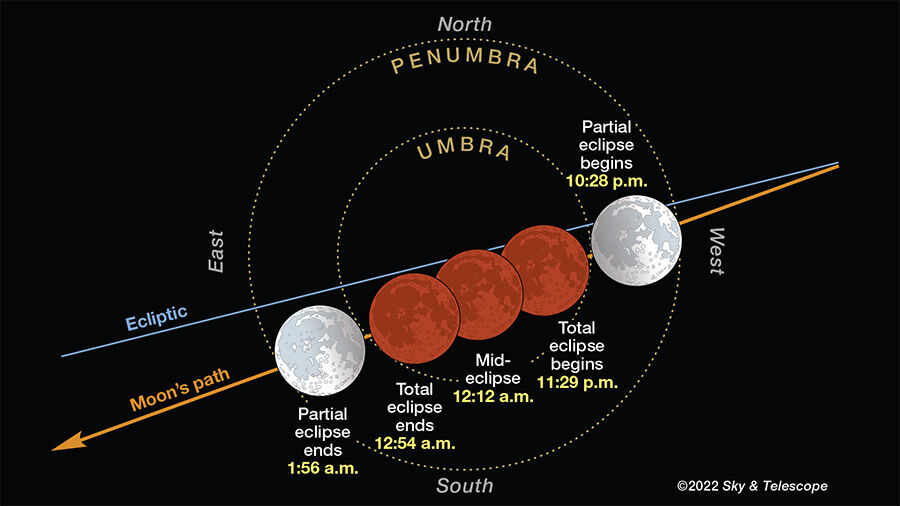It has been almost one year to the day when the last total lunar eclipse occurred, and overnight Sunday into Monday, half of the planet will be treated to a total lunar eclipse. That’s the good news. The bad news is the cloud cover forecast for the D.C. area, which may make it not that great of an event.
All is not lost if it is partly cloudy, as you could still see the eclipse through breaks in the clouds. In fact, clouds can provide quite a dramatic view of the sky scene during the eclipse.
My best advice for everyone is to monitor the local weather forecast. Thunderstorms are a possibility and you do not want to be outside if there is even a chance of lightning. Remember: Hear the roar, go indoors. Do an eyeball check of the sky at the times of each phase of the eclipse to see what your cloud cover looks like. You might get lucky.
Here’s a timeline of the eclipse from EarthSky:
- Penumbral eclipse begins at 9:32 p.m. EDT on May 15.
- Partial eclipse begins at 10:27 p.m. EDT on May 15.
- Totality begins (moon engulfed in Earth’s shadow) begins at 11:29 p.m. EDT on May 15.
- Totality ends at 12:53 a.m. EDT.
- Partial eclipse ends at 5:55 1:55 a.m. EDT.
- Penumbral eclipse ends at 2:50 a.m. EDT.
- Maximum eclipse is at 12:12 a.m. EDT.
- Duration of totality: About 85 minutes.
If the cloud gods win, all is not lost. You can watch the eclipse online.

May’s full moon is called flower because of all the flowers in bloom in the month of May. This full flower moon is also a supermoon, as it occurs almost when it is closest to Earth for the month. To experienced moon watchers the full flower supermoon will look a bit larger and brighter than other full moons.
You will also see the phrase “blood moon” used to describe this eclipse, as that has come into vogue the last few years.
It will be interesting to see if the Tonga volcano eruption in January will make the totality phase darker than usual. I witnessed the December 1992 total lunar eclipse in Guam, and it was very difficult to see the Earth’s shadow during totality, even with a telescope. The 1991 eruption of Mount Pinatubo in the Philippines put a lot of volcanic debris and aerosols in the Earth’s atmosphere so that the Sun’s rays were significantly dimmed as they passed through. This greatly reduced how bright totality was, the Earth’s shadow was almost a very dark brown-black in color.
If you want to try to see the eclipse, it is very easy to do so, cloud cover not withstanding. Even in cities, the moon and eclipse phases will be visible, although being away from the glare of bright lights is highly recommended. At totality the moon will be near the Milky Way, which should become visible from dark sky sites, making for a beautiful and dramatic sky sight.
For the D.C. area, the moon will be in the southeast sky, well above the horizon but you want to make sure you are free of trees and buildings that could block your view.
Binoculars will help immensely and are highly recommended — mandatory really — to try to see any shading on the moon during the penumbral eclipse phases; or if it is a dark, totality phase. They will greatly enhance your view of the other eclipse phases.
Using an adjustable lounge chair to keep comfortable during the long eclipse is also recommended. Lay back and relax to see this spectacular sky show.
Any camera will easily capture the various phases of the eclipse. This includes smartphones and even tablets with cameras.
Bottom line: Monitor the weather, but check visually to see if there are any breaks in the clouds. You can also watch the eclipse online, while you are doing your visual checks. Try getting some images, but make sure you just simply enjoy the sky show.
If you want more space-related activity this weekend, D.C.-area students are in the national finals of the world’s largest student rocketry competition that will be held Saturday, with Sunday as the alternate weather date.
Save the date
Speaking of rockets, “NASA and Boeing are targeting launch of the company’s CST-100 Starliner spacecraft on a United Launch Alliance Atlas V rocket at 6:54 p.m. EDT on Thursday, from Space Launch Complex-41 on Cape Canaveral Space Force Station in Florida.
This is the second uncrewed flight test of the Starliner spacecraft for NASA’s Commercial Crew Program,” as explained in a NASA email. You can sign up as a virtual guest to receive the very latest on the mission.
Follow Greg Redfern’s daily blog to keep up with the latest news in astronomy and space exploration. You can email him at skyguyinva@gmail.com, or follow him on Twitter.







